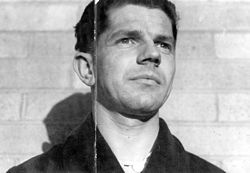The following extract is taken from a longer biographical piece of Harold Stewart (1916-95) for the revolvy website. Click here to see the full piece.
***********
 [Hal Stewart] visited Japan in 1961 and then again in 1963 to be ordained as a Jōdo Shinshū priest only to withdraw at the last minute. It was rumoured he did not want to have his hair shaven. He returned to Australia and later enticed Masaaki, the Japanese man he had fallen in love with, to visit. Masaaki claims to have built the first Japanese-style garden in Australia in the Dandenongs. In 1966 he left Australia to live permanently in Japan. He devoted himself to studying the doctrines of Shin Buddhism to which he had converted. He became an expert on the history of Kyoto and was intimately acquainted with its temples, gardens, palaces and works of art. He became fascinated with Japanese poetry and published two translations of haiku: A Net of Fireflies (1960) and A Chime of Windbells (1969) which proved popular with the reading public.
[Hal Stewart] visited Japan in 1961 and then again in 1963 to be ordained as a Jōdo Shinshū priest only to withdraw at the last minute. It was rumoured he did not want to have his hair shaven. He returned to Australia and later enticed Masaaki, the Japanese man he had fallen in love with, to visit. Masaaki claims to have built the first Japanese-style garden in Australia in the Dandenongs. In 1966 he left Australia to live permanently in Japan. He devoted himself to studying the doctrines of Shin Buddhism to which he had converted. He became an expert on the history of Kyoto and was intimately acquainted with its temples, gardens, palaces and works of art. He became fascinated with Japanese poetry and published two translations of haiku: A Net of Fireflies (1960) and A Chime of Windbells (1969) which proved popular with the reading public.
His 1981 book By the Old Walls of Kyoto consists of twelve poems in rhyming couplets celebrating Kyoto’s landmarks and antiquities, and Stewart’s own spiritual pilgrimage into Buddhism. The poems are accompanied by a prose commentary.
He also devoted a great deal of time to collaborating with his teachers, Shojun Bando and Hisao Inagaki, in producing English versions of Japanese Buddhist classics such as the Three Pure Land Sutras and theTannisho.
Stewart died in Kyoto on 7 August 1995 after a short illness. A Shin Buddhist ceremony was conducted for him. His body was cremated and his ashes scattered on His beloved Higashiyama mountains. He left a sum of money (about AU$250,000), some of which was intended to fund the publishing of his last long poem, Autumn Landscape Roll, but none of the money was used for this purpose. His sister was one of the executors of the will and inherited all the funds except for a separate benefice to his nephew from the above amount.






Recent Comments